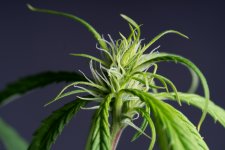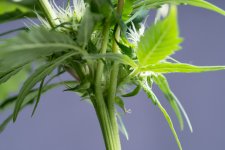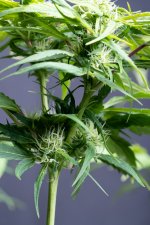considering she was a lone survivor its very likely that
a) already had extra chromosome(s) (21 to 29)leading to larger cell organ size allowing survival. or
b) the stress led to spontaneous chromosome doubling during mitosis and became a tetraploid
there have been many instances of aneuploids in landraces but only one true tetraploid population has been found so far. it is located in darcha a cold high altitude desert biome in himalayas. this inhospitable environment is famous for creating / encouraging tetraploids due to the survival factor better water retention of larger cells etc.
the areas around darcha in himchal pradesh(shimla) there are tons of chromosome mutants of all different types. a real grab bag. landrace mafia has documented quite a few sterile females/faciated/abnormally large plants in malana/wailing farmers even point out specific areas of the mountain which are more likely to produce these outliers.
when there is a polyploid population close to a normal diploid wind pollination/seed dispersal of the tetraploid pollen will create a butterfly effect on the surrounding populations making hybrid swarms just like those seen in himchal pradesh.
pollen size and genome content is directly related to chromosome counts so its much more effective then females at passing on extra chromosomes this may be a large part of why nevils 69 males retained more of these primal traits. even without intentional selection this mixoploid pollen will persist for couple generations.
triploids meiosis(embryo creation) is the main driver of aneuploids(more then 20 but less then 30/incomplete extra set). this is due to 3 sets of chromosomes with only 2 poles to migrate towards. inevitably there are laggards,broekn chromosome arms etc.
one cool way to figure out if its an aneuploid is to self it- just like we are seeing in a5s1 a selfed aneuploid will have huge pheno variation and mutations far beyond a normal f2 spread.



this is a crazy mango haze seedling which matches the abnomal tumor like germination in the article. the endosperm on this thing was out of control i accidentally detached it too early and the monster never recovered. dumb ass. lol

%20Suman%20Kaushal%20Kangra.pdf
a) already had extra chromosome(s) (21 to 29)leading to larger cell organ size allowing survival. or
b) the stress led to spontaneous chromosome doubling during mitosis and became a tetraploid
there have been many instances of aneuploids in landraces but only one true tetraploid population has been found so far. it is located in darcha a cold high altitude desert biome in himalayas. this inhospitable environment is famous for creating / encouraging tetraploids due to the survival factor better water retention of larger cells etc.
the areas around darcha in himchal pradesh(shimla) there are tons of chromosome mutants of all different types. a real grab bag. landrace mafia has documented quite a few sterile females/faciated/abnormally large plants in malana/wailing farmers even point out specific areas of the mountain which are more likely to produce these outliers.
when there is a polyploid population close to a normal diploid wind pollination/seed dispersal of the tetraploid pollen will create a butterfly effect on the surrounding populations making hybrid swarms just like those seen in himchal pradesh.
pollen size and genome content is directly related to chromosome counts so its much more effective then females at passing on extra chromosomes this may be a large part of why nevils 69 males retained more of these primal traits. even without intentional selection this mixoploid pollen will persist for couple generations.
triploids meiosis(embryo creation) is the main driver of aneuploids(more then 20 but less then 30/incomplete extra set). this is due to 3 sets of chromosomes with only 2 poles to migrate towards. inevitably there are laggards,broekn chromosome arms etc.
one cool way to figure out if its an aneuploid is to self it- just like we are seeing in a5s1 a selfed aneuploid will have huge pheno variation and mutations far beyond a normal f2 spread.
this is a crazy mango haze seedling which matches the abnomal tumor like germination in the article. the endosperm on this thing was out of control i accidentally detached it too early and the monster never recovered. dumb ass. lol
%20Suman%20Kaushal%20Kangra.pdf






